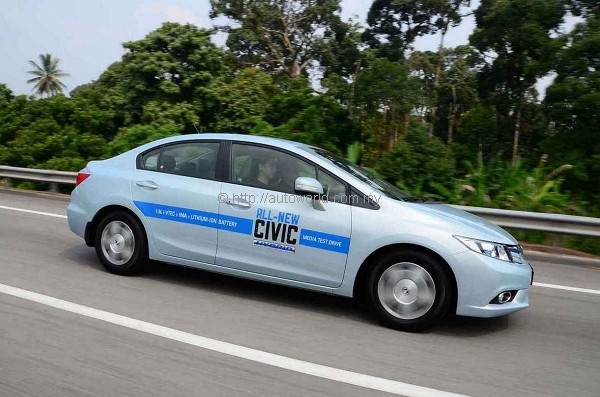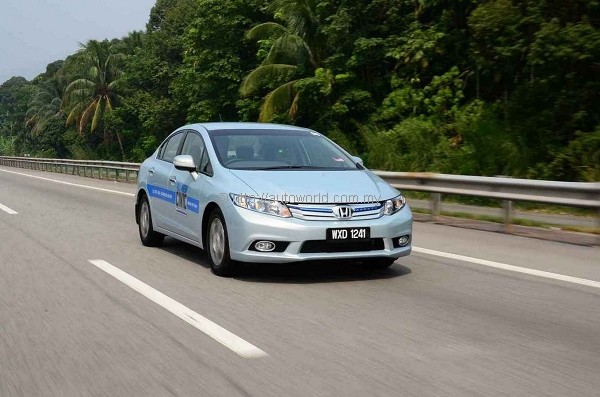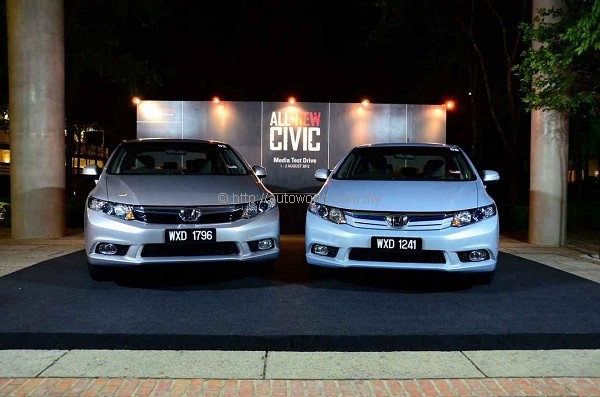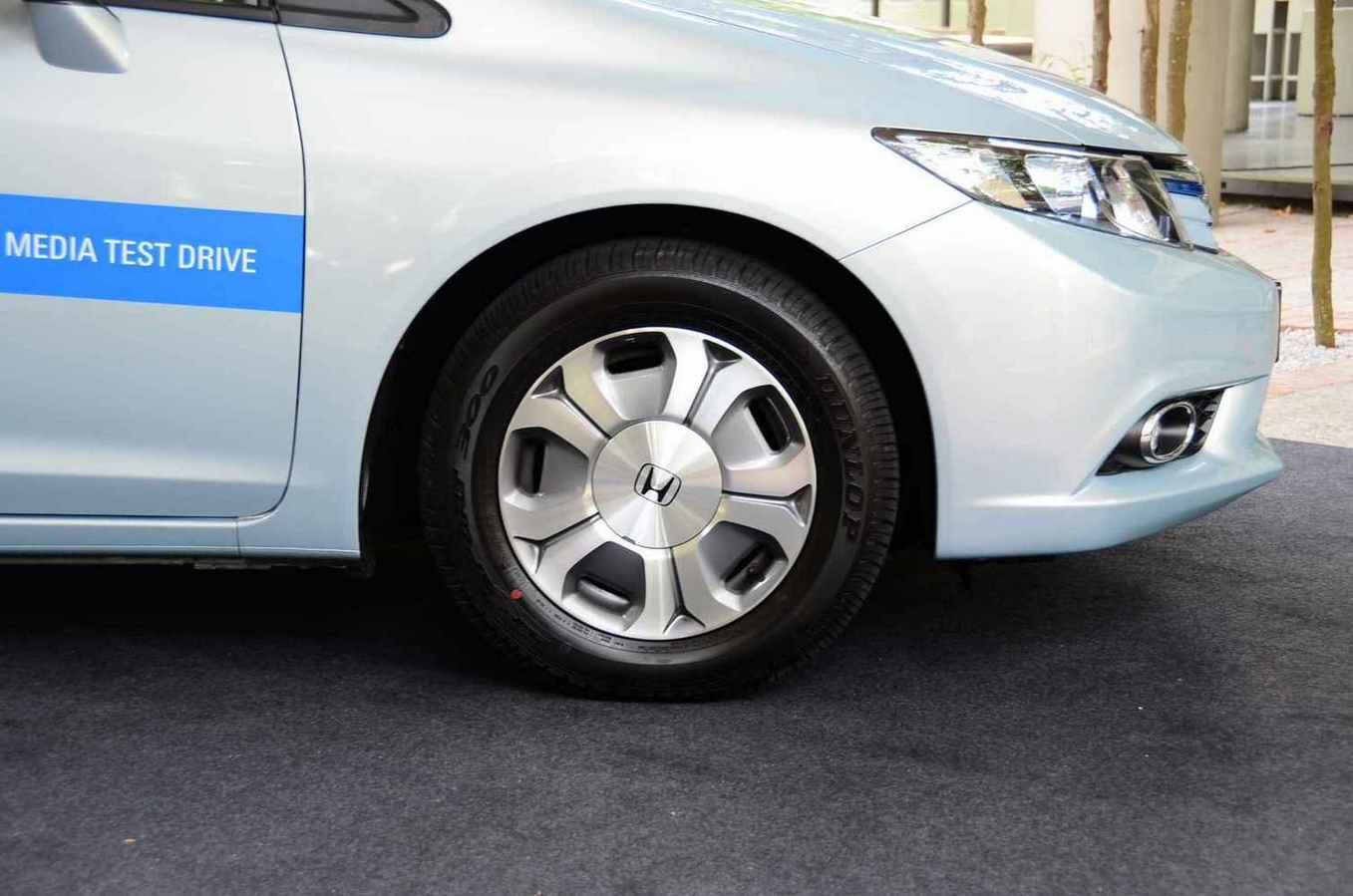Honda Civic Hybrid Test Drive
With a 1.5 litre engine, the new 2013 Honda Civic hybrid certainly drives better than the previous model which came with a 1.3 litre engine. Mechanically, the new Civic hybrid is similar to the CR-Z, both having the same capacity and lithium-ion batteries, the latter of which I did predict would one day be used in hybrid vehicles. However, the tuning of the drive train on the Civic hybrid is geared more towards fuel economy – thus it develops a max power rating of 111 PS @ 5,500 rpm, compared to the 124 Ps @ 6,000 rpm for the CR-Z (combined power of engine and IMA motor). Maximum torque numbers for the Civic is 2Nm short of the CR-Z at 172Nm.
Stacking this against the Civic 1.8 litre’s 140 PS and 174Nm max torque from its naturally aspirated engine, the Civic hybrid loses out in outright power, but in actual driving, the combined torque of 172 Nm from the 1.5 litre engine and IMA motor of the hybrid gives it an acceleration sensation pretty close to that of the 1.8 Civic. What the hybrid system does in the Civic hybrid is to provide the user with greater fuel economy – basically, given a set style of driving, the Civic hybrid potentially uses less fuel per kilometre than the 1.8 litre Civic, due partly to the smaller engine capacity, the fuel programming, and of course the savings from the hybrid system, namely the auto-stop function, the energy-regeneration and the Integrated Motor Assist (IMA).
In actual long distance driving, the hybrid system does not contribute as much, but every time you lift off or brake, some energy-regeneration occurs, and this energy is used to supplement the power train at a later stage. How much fuel you save really depends on your right foot, but always remember, that a hybrid system still accords some fuel savings – the lighter your foot, the more the savings.
The Civic hybrid uses the same base body as the regular civic, but has some additional aero-dynamic details, such as smaller apertures in the grille, which allows less air into the engine compartment (the smaller capacity engine requires less air for cooling), and the car actually sits 5mm lower than its non-hybrid siblings. In addition, the drag coefficient is reduced by the addition of under-body panels to smoothen the air flow under the car. The lights and grille have tinges of blue to distinguish the hybrid from the regular Civic, and even the wheels are designed to reduce the drag.
Driving around in a hybrid is an unfamiliar (not necessarily bad) experience to me – I tend to drive the car with the thought of getting the best mileage at the start, but as the day goes by, my old habits catch up, and I end up speeding and driving hard. In the end, I don’t get the mooted fuel consumption figures, not because the car is no good, but because my right foot is too heavy on the throttle. Still, after all the hard driving at full bore, I managed an overall consumption figure of 12.8 kilometres per litre. Translated to a more familiar figure to me, it is 7.8 litres per 100 kilometres, which is a very respectable figure. Most of my driving was out of town, it being Chinese New Year. If you are a ‘normal’ driver, and stick to the speed limits, you are likely to get better numbers than what I got. If you do a lot of city commuting in your car, the Civic hybrid will really save you plenty of money in fuel costs.
The Civic hybrid’s air-conditioning system is a little different from the systems in the Jazz hybrid, and the Insight – the compressor keeps on pumping even while the engine is stopped (auto-stop function) when you are at a traffic light or stopped in traffic – generally, this means you will not lose the air-conditioning when you are on auto-stop, provided there is enough juice in your battery pack to power the compressor. In contrast, the Jazz and Insight hybrids only have a mechanically-driven compressor that stops when the engine is on auto-stop, and only the blower functions.
The lithium-ion batteries have a longer life than the regular nickel-metal hydride batteries, and are more compact in structure. Whereas the previous Civic had a cylindrical shaped battery pack, the new Civic has a rectangular and flat shape, and is more compact. (Please read the extract below on the difference between Lithium-ion and Nickel Metal hydride batteries). The benefits are manifold, including weight savings, less ‘memory effect’, and the ability to charge and discharge faster. Anyway, for general information, it is only a matter of time before all hybrids adopt lithium-ion batteries for obvious reasons.
The entire driving experience I had with the Honda Civic hybrid was quite pleasant – you get the impression the car will go on forever on that little 50-litre tank of gas, especially when you are easy on the throttle. Switching the on-board display to show the hybrid system at work is also quite interesting. You can graphically see the way power is going to your engine, or when the engine is charging your batteries. At low speeds without load, you can drive solely on electric power provided there is enough charge in your battery pack. I drove mostly on ‘ECON’ mode, which gives the best fuel economy – even when I was pushing the car, I kept it in ECON. If you Shift to ‘S” (Sport) mode, the engine responds a little better, but not by much – it was too much bother to switch from one to the other, so I left it in ECON most of the time, after having played with the two modes for a while.
The sixty-four dollar question is whether the Honda Civic is suitable or not. My answer? It depends on you, really. If you are a person who commutes daily in a city environment, with little or no chances for high speed driving (140 kmh and above), and would like to save fuel, then the Civic Hybrid is the car for you. If you are like me, one who likes to drive fast, and get high on having your body pushed back against the seat on strong acceleration, and do a high proportion of out-station and long distance driving, then perhaps not. Mind you, the Civic hybrid will be able to travel the length and breadth of the country, at decent speeds too, if you require it to do so – it is a little like the 1.8 litre Civic – therefore, if you are looking for something in that territory, the Civic hybrid is good enough. As for me, what I would like is a hybrid that has a base power of around 200 horses, which can come from a turbocharged or supercharged engine – that would be nice.














































